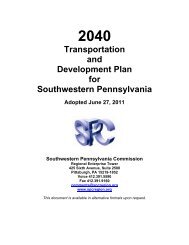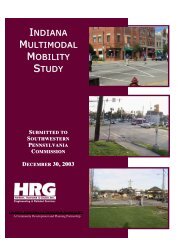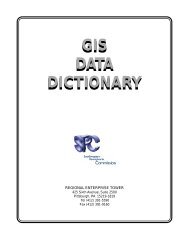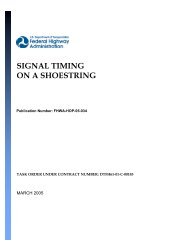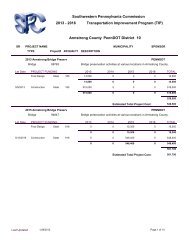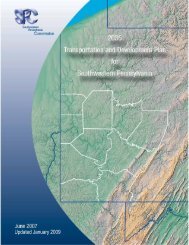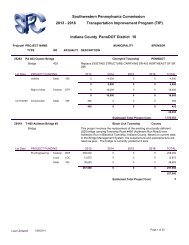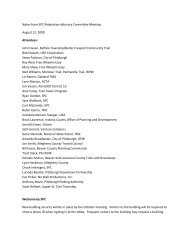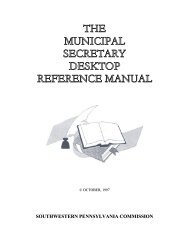Adaptive Control Software – Lite (ACS-Lite) Implementation Template
Adaptive Control Software – Lite (ACS-Lite) Implementation Template
Adaptive Control Software – Lite (ACS-Lite) Implementation Template
You also want an ePaper? Increase the reach of your titles
YUMPU automatically turns print PDFs into web optimized ePapers that Google loves.
<strong>Adaptive</strong> <strong>Control</strong> <strong>Software</strong> <strong>–</strong> <strong>Lite</strong><br />
(<strong>ACS</strong>-<strong>Lite</strong>)<br />
<strong>Implementation</strong> <strong>Template</strong><br />
Developed by: FHWA Resource Center <strong>–</strong> Operations Technical Support Team<br />
September 2006
Purpose<br />
<strong>Adaptive</strong> <strong>Control</strong> <strong>Software</strong> <strong>Lite</strong> (<strong>ACS</strong>-<strong>Lite</strong>) is a tool designed specifically to improve<br />
signal timing on closed-loop traffic signal systems. Given the prevalence and wide<br />
distribution of closed-loop traffic signal systems throughout the United States and the<br />
relatively low deployment cost and infrastructure requirements of <strong>ACS</strong>-<strong>Lite</strong>; great<br />
potential exists for improving the quality of signal timing. Considering the (D-) grade<br />
assigned nationally to traffic signal operations by the NTOC in 2005, and the estimated<br />
300 million Vehicle hours of delay attributable to poor signal timing on major roadways,<br />
this technology is long overdue.<br />
The public-private partnerships formed to develop and distribute <strong>ACS</strong>-<strong>Lite</strong> are<br />
anticipated to enhance and facilitate deployment of the system and have already<br />
generated a significant level of interest. It is imperative that the FHWA Resource Center,<br />
Research and Development, Office of Transportation Management, and Division Offices<br />
deliver consistent and accurate information about the capabilities, functionality and<br />
limitations of <strong>ACS</strong>-<strong>Lite</strong> as any of the partners may serve as a point of contact by agencies<br />
seeking to acquire information about the system. The purpose of this template is to<br />
provide a framework to effectively promote and support the deployment of <strong>Adaptive</strong><br />
<strong>Control</strong> <strong>Software</strong> <strong>Lite</strong> (<strong>ACS</strong>-<strong>Lite</strong>). This template includes discussion of the following<br />
aspects of <strong>ACS</strong>-<strong>Lite</strong>:<br />
• Background<br />
• Key Features<br />
• Limitations<br />
• Benefits<br />
• Cost<br />
• How to Obtain <strong>ACS</strong>-<strong>Lite</strong><br />
• Marketing Material<br />
The template also includes an appendix with detailed technical information, Frequently<br />
Asked Questions (FAQs), field test information and contact information for the project<br />
partners. Development of a workshop is being considered to provide information about<br />
how to improve signal timing operations and maintenance with a focus on <strong>ACS</strong>-<strong>Lite</strong>.<br />
Background<br />
The FHWA undertook a ten year effort beginning in 1992 to develop <strong>Adaptive</strong> <strong>Control</strong><br />
<strong>Software</strong> (<strong>ACS</strong>) that modified signal timing to accommodate changing traffic patterns.<br />
The results of this effort were five control strategies that operated effectively on several<br />
configurations of arterial systems including grid networks. The most widely deployed of<br />
these algorithms was RHODES, credited with using a predictive optimization technique<br />
that was easily configured. <strong>Adaptive</strong> <strong>Control</strong> <strong>Software</strong> (<strong>ACS</strong>) has been found to produce<br />
significant reductions in travel time, delay and fuel consumption. The drawback of the
<strong>ACS</strong> systems was/is the high cost of deployment. Fully adaptive traffic signal control<br />
systems typical cost $10,000 to $40,000 per intersection and require significant<br />
maintenance and professional staff to perform optimally. The cost of deployment has<br />
proven prohibitive for most public agencies despite the numerous benefits that have been<br />
documented.<br />
In 2001 the FHWA recognized both the benefits and cost barriers to adaptive control<br />
systems and undertook an effort to make <strong>ACS</strong> technology accessible to jurisdictions that<br />
cannot afford to invest in centrally managed <strong>ACS</strong> systems. Closed Loop Systems (CLS)<br />
are the most prevalent signal control systems in the United States. <strong>ACS</strong>-<strong>Lite</strong> is designed<br />
specifically for closed loop systems with the express goal of being low-cost to make it<br />
widely accessible to most small to medium size jurisdictions. The cost to deploy <strong>ACS</strong>-<br />
<strong>Lite</strong> is equivalent to the cost of a typical traffic signal retiming project; which ranges<br />
$1500 - $3500 per intersection. <strong>ACS</strong>-<strong>Lite</strong> was developed initially to be deployed on<br />
arterial routes and is not currently appropriate for grid networks. The types of arterial<br />
facilities utilized during the <strong>ACS</strong>-<strong>Lite</strong> field tests are indicative of the types of facilities<br />
where <strong>ACS</strong>-<strong>Lite</strong> will prove to be most effective.<br />
Key Features<br />
• FHWA initiated the <strong>ACS</strong>-<strong>Lite</strong> program to assess, and then pursue, the best, most<br />
cost-effective solution for applying <strong>ACS</strong> technology to current, state-of-thepractice<br />
closed-loop traffic signal control systems.<br />
• Several National Electrical Manufacturers Association (NEMA) closed-loop<br />
traffic control system vendors (Econolite, Eagle, Peek, and McCain) have<br />
provided guidance and support to the <strong>ACS</strong>-<strong>Lite</strong> team.<br />
• <strong>ACS</strong>-<strong>Lite</strong> is designed specifically for closed loop systems; 90% of the traffic<br />
signal systems in the U.S. are estimated to be closed loop systems (this does not<br />
mean all closed loop systems are suited for <strong>ACS</strong>-<strong>Lite</strong> Deployment, nor does it<br />
indicate that 90% of all traffic signals are controlled by closed-loop systems).<br />
• <strong>ACS</strong>-<strong>Lite</strong> is intended to make <strong>Adaptive</strong> <strong>Control</strong> System (<strong>ACS</strong>) technology widely<br />
accessible without the upgrade and maintenance costs required to implement the<br />
full <strong>ACS</strong> systems.<br />
• <strong>ACS</strong>-<strong>Lite</strong> uses NTCIP for data and control.<br />
• <strong>ACS</strong>-<strong>Lite</strong> provides adaptive control within the readily-understandable and<br />
standard context of cycle, splits, and offset.<br />
• <strong>ACS</strong>-<strong>Lite</strong> downloads new parameters to each controller every 5-15 minutes and<br />
the local controller performs the second-by-second control of the intersection.
• <strong>ACS</strong>-<strong>Lite</strong> does not have the high vehicle detector requirements typically<br />
associated with adaptive systems.<br />
• Simulation studies and field test show significant delay and travel time<br />
improvement is possible on the arterial route.<br />
• <strong>ACS</strong>-<strong>Lite</strong> was developed to run on Windows-XP embedded on a field-hardened<br />
PC platform in a controller cabinet either replacing the master controller or<br />
working in concert with the master, depending on the controller manufacturer.<br />
Limitations<br />
• <strong>ACS</strong>-<strong>Lite</strong> is currently limited to NEMA closed-loop traffic control systems<br />
manufactured by Eagle (SEPAC NTCIP v4.01b), Econolite (ASC/2 NTCIP) or<br />
PEEK (3000E with NTCIP translator hardware). Other controller models may be<br />
compatible with the system in the future. This may limit deployment options.<br />
• The McCain test in El Cajon, CA will use BiTran 233 software on 170 local<br />
controllers and a 2070 NTCIP McCain Master controller currently being<br />
developed. More information will be available on this field test after November<br />
2006.<br />
• <strong>ACS</strong>-<strong>Lite</strong> was not designed to operate on grid networks or to provide optimization<br />
on several major crossing arterials. Currently progression has only been tested<br />
along a single route, crossing routes are a possibility but not for simultaneous<br />
progression.<br />
• <strong>ACS</strong>-<strong>Lite</strong> requires a minimum of 9600 baud communications and is limited to 12<br />
intersections at this baud rate. Higher baud rates or IP communications eliminates<br />
this limitation.<br />
• The TOD Tuner algorithm (long-term signal system parameter maintenance) has<br />
not yet been developed and may require several years to be fully incorporated into<br />
the software.<br />
• The Operations and Maintenance requirements are still being explored, a good<br />
estimate of the requirements in this area may not be available until after early<br />
adopters deploy the system.<br />
• <strong>ACS</strong>-<strong>Lite</strong> may prolong the onset of saturated conditions but does not currently<br />
have logic to shift its operational strategy to manage saturated conditions.
• <strong>Control</strong>ler manufacturers not participating in the initial development of <strong>ACS</strong>-<strong>Lite</strong><br />
will have to purchase a software license from Siemens. The license and royalty<br />
fees have not yet been determined.<br />
• <strong>ACS</strong>-<strong>Lite</strong> will not solve poor planning and design features that create bottlenecks<br />
and congestion on arterials. These issues should be considered first, signal timing<br />
has limited ability to remove traffic congestion.<br />
Benefits<br />
• Reduce delay and improve travel time by keeping the signal timing plans<br />
current.<br />
• Improve platoon progression.<br />
• Reduce emissions (hydrocarbons, carbon monoxide, NOx).<br />
• Reduce fuel consumption.<br />
• Increase agency efficiency and productivity.<br />
• Reduce capital, operating and maintenance costs by reducing the need for<br />
signal retiming.<br />
• Easily configured and calibrated.<br />
• Compatible with existing closed loop systems.<br />
• Locks in the performance gains of signal retiming.<br />
• Developed through a public private partnership.<br />
Cost<br />
The cost of <strong>ACS</strong>-<strong>Lite</strong> should be broken down into categories; infrastructure and<br />
integration. <strong>ACS</strong>-<strong>Lite</strong> requires a compatible system of traffic signal controllers on a<br />
closed loop system that meet minimal communications and detection requirements.<br />
<strong>ACS</strong>-<strong>Lite</strong> is considered an upgrade or retrofit to an existing system. Free of<br />
infrastructure cost, which is readily quantifiable, a fair estimate of <strong>ACS</strong>-<strong>Lite</strong> integration<br />
cost might range between $10,000 and $30,000 depending on the size and complexity of<br />
the system. Compare this cost with the cost of a routine traffic signal retiming project<br />
which generally ranges $2000 - $3500 per intersection. The funding mechanisms for<br />
traffic signal retiming can also be applied to <strong>ACS</strong>-<strong>Lite</strong> deployment.<br />
How to Obtain<br />
<strong>ACS</strong>-<strong>Lite</strong> will only be available through the vendors that accepted the invitation to<br />
participate in the <strong>ACS</strong>-<strong>Lite</strong> program. The vendors include Econolite, Siemens (Eagle),
McCain and Peek. To obtain <strong>ACS</strong>-<strong>Lite</strong> an agency should contact the appropriate vendor<br />
according to the type of system they are currently operating. If a system replacement is<br />
planned utilizing one of the participating vendor’s traffic signal control products, <strong>ACS</strong>-<br />
<strong>Lite</strong> should be specified for inclusion with the new system.
Marketing Material<br />
The <strong>ACS</strong>-<strong>Lite</strong> Marketing Materials will include:<br />
• Tri-fold leaflets<br />
• Executive Multimedia presentation, highlighting testimonials from the test site<br />
engineers, vendors and development team.<br />
• Website http://www.ops.fhwa.dot.gov/arterial_mgmt/acs_lite/index.htm<br />
• <strong>ACS</strong>-<strong>Lite</strong> Workshop<br />
• <strong>ACS</strong>-<strong>Lite</strong> displays at professional conferences<br />
• <strong>ACS</strong>-<strong>Lite</strong> Technical Session at ITE Spring and Annual Meeting 2007.<br />
• <strong>ACS</strong>-<strong>Lite</strong> Article in ITE Journal<br />
• <strong>ACS</strong> Full Page Advertisement in ITE Journal<br />
• Signal Timing on A Shoestring Workshop<br />
• <strong>ACS</strong>-<strong>Lite</strong> Webcast http://www.ntoctalks.com/web_casts_archive.php<br />
• <strong>ACS</strong>-<strong>Lite</strong> presentations by FHWA Resource Center<br />
• Marketing efforts of vendors
APPENDIX<br />
Technical Information †<br />
Functionality<br />
<strong>ACS</strong>-<strong>Lite</strong> provides adaptive control within the industry standard context of cycle, splits,<br />
and offset utilizing three control algorithms. The control algorithms include a Run Time<br />
Refiner, Transition Manager and Time of Day Tuner. Figure 1 below describes how the<br />
algorithms work in tandem to update traffic signal timing on a cyclical basis.<br />
Figure 1. Illustrates the control strategy that <strong>ACS</strong>-<strong>Lite</strong> employs to update traffic<br />
signal timing.<br />
Run Time Refiner<br />
The Run Time Refiner is tasked with adapting to traffic in real-time by changing cycle,<br />
splits, and offsets in small, incremental steps and downloading these changes to the<br />
controller every 5-15 minutes. These small steps serve two purposes:<br />
(1) Minimize the effects of transition from one plan set to another and<br />
(2) Reduce the risk of the controller being sent by <strong>ACS</strong>-<strong>Lite</strong> into a poor set of plan<br />
parameters due to failed detectors, loss of communications, or other anomalies.
The Run-Time Refiner utilizes the optimization principles of balancing the degree of<br />
phase utilization on each phase, by tuning splits, and capturing the most traffic as<br />
possible on the coordinated phases during the green, by tuning offsets. These two<br />
algorithms use the concept of being “driven directly by the data” using very simple<br />
models of how predicted changes to parameters impact the operation. In essence, <strong>ACS</strong>-<br />
<strong>Lite</strong> operates on the principle that the recent past predicts the near future (i.e. the<br />
conditions you see now will continue in the next few cycles). While the performance<br />
response times (i.e. how long it takes <strong>ACS</strong>-<strong>Lite</strong> to find the “right” set of traffic<br />
parameters for a given situation) suffer slightly due to the lack of a traffic model, the<br />
savings in configuration and maintenance/calibration are substantial. Both algorithms<br />
use a “surrogate” measure for delay & stops rather than attempting to calculate delay<br />
from a vehicle-movement-based traffic model.<br />
Split tuning<br />
The split adjustment algorithm executes on each controller independently. The cycle<br />
time is assumed to be fixed and constant on all controllers in the system, although this is<br />
not a necessary assumption. First, the surrogate performance measure phase utilization is<br />
calculated for each split by determining how much of the available green time is being<br />
used. Essentially this is a measure of the degree of saturation on the approach. Splits<br />
that are using all of their allotted time being occupied by traffic are candidates for<br />
increased split values. Similarly, splits that are not using all of their available green over<br />
the last few cycles are candidates to give up their time to other phase splits. The basic<br />
algorithm reduces the maximum predicted phase utilization of any phase on the controller<br />
by exchanging time amongst the various phases. This has the net effect of balancing the<br />
degree of utilization across all phases. To preserve opportunities for progression on<br />
coordinated movements, a bias is added to each coordinated phase utilization estimate to<br />
ensure extra green time is allocated to the coordinate phase. This is visualized cycle-bycycle<br />
on the <strong>ACS</strong>-<strong>Lite</strong> software interface as shown in Figure 2.<br />
Figure 2. Example of phase utilization estimates for an intersection.<br />
Figure 2 shows the phase utilization percentage and a color-coded representation (green<br />
for low utilization, yellow for medium, and red for high utilization). The numbers above<br />
the average utilization estimate indicate the maximum flexibility that <strong>ACS</strong>-<strong>Lite</strong> has to
modify the split, if necessary and possible. For example, phase 2 shows a current split of<br />
80. Its theoretical minimum is 26 (perhaps constrained by the walk + ped clearance time)<br />
and theoretical maximum is 107. Expressed as a difference from 80 seconds, the second<br />
row shows that the split could go down by 54 seconds or up by 27 seconds from its<br />
current setting of 80. Since the algorithm must maintain the current cycle length, for<br />
example, it would be possible if the traffic was very light to reduce all of the splits to<br />
their minimum value.<br />
In this manner, <strong>ACS</strong>-<strong>Lite</strong> adjusts the splits of the controller assuming the general<br />
structure of North American controllers with rings, barriers, and phases. Split-phasing,<br />
overlaps, extension times, gap-out logic, “adaptive” protected/permitted lefts, and all<br />
standard or vendor-specific features and operational behaviors of existing controllers are<br />
left intact. Any number of phases, rings, and barriers are compatible with the Run-Time<br />
Refiner algorithms with the assumption that each barrier crosses all rings. More<br />
sophisticated search algorithms are necessary to mitigate barriers that do not cross all<br />
rings.<br />
Offset Tuning<br />
Two offset adjustment methods were developed based upon the same principle of<br />
“capturing” the maximum amount of (statistically) progressed traffic flow in the green<br />
band provided by the coordinated phase. For each iteration of the algorithm, a small<br />
positive change, no change, or a small negative change to the offset value are evaluated.<br />
The Distributed Offset Adjustment (DOA) algorithm adjusts the offsets at each<br />
intersection independently, while also considering the effects of the offset changes on the<br />
arriving platoons at upstream and downstream intersections. The Network Offset<br />
Adjustment (NOA) algorithm adjusts the offsets of all the intersections in the system to<br />
capture the most (statistically) progressed traffic flow among all possible combinations of<br />
offset adjustments. The <strong>ACS</strong>-<strong>Lite</strong> user-interface software allows the size of adjustments<br />
for each optimization to be determined as well as the type of offset adjustment algorithm<br />
to use (NOA or DOA). In addition to these methods, an offset selection algorithm was<br />
also developed to provide more of a “traffic responsive” mode of operation for locations<br />
without advanced loops at every intersection.<br />
The calculation of a “statistical flow profile” and the surrogate for progressed traffic<br />
(delay & stops) is demonstrated in Figure 3. As shown below, the statistical flow profile<br />
is derived from the last few cycles of occupancy collected at the upstream detector(s).<br />
For each second of the cycle, the average occupancy and volume is computed. Similarly<br />
for each second of the cycle, the probability that the light is green during that second is<br />
calculated. Using these two estimates, the “capture efficiency” of the phase for the<br />
current offset value and alternative offset values are calculated, and the best results is<br />
selected and downloaded to the controllers.
Figure 3. Offset tuning from statistical flow profiles<br />
Transition Manager<br />
When transitioning between one plan and another, <strong>ACS</strong>-<strong>Lite</strong> manages the transition to<br />
minimize the time spent out of coordination. Transition between two distinct timing<br />
plans is a process that depends on the closed-loop system or controller manufacturer, and<br />
the configured transition mode. There are several standard transition strategies.<br />
• Short way (reduced splits, shorter cycle)<br />
• Long way (increased splits, longer cycle)<br />
• Dwell (hold in the synch phase until it is in coordination)<br />
• Best way (calculate whether short way or long way will be faster)<br />
Whether it is best for a particular controller to transition short way or long way depends<br />
on (amongst other factors) the difference between the pattern offsets. The Transition<br />
manager accepts a transition request from the Run-Time Refiner and either chooses the<br />
best transition method or prepares an incremental set of steps that performs better than<br />
allowing the controller to manage the process itself.<br />
The traditional goal of transition is simply to get into sync with the new pattern as<br />
quickly as possible. However, <strong>ACS</strong>-<strong>Lite</strong> may be able to apply a more sophisticated basis<br />
for selecting a transition mode. Specifically, the quickest path to synchronization may<br />
not be the most beneficial path in terms of traffic performance. For instance, when<br />
signals are saturated, short way transition (which may be the quickest path to<br />
synchronization) may cause queues to buildup, which cannot be dissipated quickly under<br />
the new plan. It may be preferable to use long way transition in this case, to ensure that
the signal is not inadvertently forced into a congestion scenario that negates the<br />
progression opportunities of the new signal plan.<br />
Time Of Day (TOD) Tuner<br />
The TOD Tuner has not yet been fully developed and incorporated into the functionality<br />
of <strong>ACS</strong>-<strong>Lite</strong>. Once complete this component will periodically update the time-of-day<br />
signal timing plans based on statistically significant changes in the underlying traffic<br />
flow. By doing this, <strong>ACS</strong>-<strong>Lite</strong> will, in essence, remember the changes to splits and<br />
offsets that have become significant as they reoccur frequently during specific times of<br />
day. <strong>ACS</strong>-<strong>Lite</strong> utilizes the base signal timing plans as the baseline for its operation and<br />
currently does not modify cycle lengths in real-time.<br />
Development & Project Partners<br />
<strong>ACS</strong>-<strong>Lite</strong> research was funded by the FHWA and developed through a partnership with<br />
Siemens ITS, Purdue University and the University of Arizona. Some key development<br />
outcomes include:<br />
• <strong>ACS</strong>-<strong>Lite</strong> is designed to operate on closed-loop systems.<br />
• Designed to leverage as much of the existing infrastructure as possible<br />
• <strong>ACS</strong>-<strong>Lite</strong> can utilize low-bandwidth communication 9600 Baud minimum to<br />
support up to twelve controllers, IP communication can support up to 32<br />
controllers.<br />
• Limited detection is required to function<br />
• National Transportation Communications for ITS Protocol (NTCIP) standards are<br />
utilized to transfer information between the <strong>ACS</strong>-<strong>Lite</strong> field processor and traffic<br />
controllers.<br />
• A web-based user interface supports configuration and adjustment of <strong>ACS</strong>-<strong>Lite</strong>,<br />
and allows the user to view status of real-time operations, retrieve log files of<br />
archived data and control decisions, and configure the adaptive algorithm and<br />
communications parameters.<br />
• <strong>ACS</strong>-<strong>Lite</strong> was developed to run on Windows-XP embedded on a field-hardened<br />
PC platform in a controller cabinet. As much as possible, the C++ code has been<br />
designed for portability to embedded platforms such as the 2070 or ATC.<br />
Siemens maintains the licensing rights for the <strong>ACS</strong>-<strong>Lite</strong> software. An invitation was sent<br />
out for traffic signal controller manufactures to participate in the integration of <strong>ACS</strong>-<strong>Lite</strong>;<br />
4 manufactures responded: Eagle, Econolite, Peek, and McCain. Other manufacturers<br />
may integrate the <strong>ACS</strong>-<strong>Lite</strong> software by purchasing a license from Siemens. Siemens has<br />
not yet determined what the licensing fee for <strong>ACS</strong>-<strong>Lite</strong> with other manufacturer’s<br />
controllers will be.
System Configuration and hardware requirements<br />
The diagrams below describe the physical connection of <strong>ACS</strong>-<strong>Lite</strong> to a typical closed<br />
loop traffic signal system. <strong>ACS</strong> <strong>Lite</strong> resides on a field hardened CPU that performs the<br />
operations of the field master. A communications link between <strong>ACS</strong> <strong>Lite</strong> and the field<br />
controllers (serial or IP over twisted-pair, fiber, wireless, etc.) allows the software to<br />
monitor and evaluate traffic conditions and provide refinements to signal timing on a<br />
cycle by cycle basis.<br />
Figure 4. Typical <strong>ACS</strong>-<strong>Lite</strong> System Configuration<br />
<strong>ACS</strong> <strong>Lite</strong> Hardware<br />
The original hardware architecture (as shown above) was designed so that the <strong>ACS</strong> <strong>Lite</strong><br />
would reside in a field hardened CPU and connect to a serial port on the OSM. However,<br />
this schema did not fit all manufacturers due to the complexity in the modifications to the<br />
OSM software. For McCain systems, <strong>ACS</strong>-<strong>Lite</strong> operates as shown in Figure 1. For Peek<br />
and Eagle systems, <strong>ACS</strong>-<strong>Lite</strong> performs the function of the master controller. For
Econolite systems, <strong>ACS</strong>-<strong>Lite</strong> communicates with each local over a second serial channel<br />
to the master, or can perform the function of the master controller.<br />
The <strong>ACS</strong> <strong>Lite</strong> field hardened CPU hardware has the following minimum requirements:<br />
Operating System: Windows XP Professional or Windows XP Embedded<br />
Processor:<br />
Intel-compatible, 366MHz<br />
RAM:<br />
512MB<br />
Hard Drive:<br />
5GB minimum, Temperature-hardened<br />
I/O:<br />
VGA, mouse, keyboard, Ethernet, Serial, USB<br />
Power Supply:<br />
120VAC<br />
Communication:<br />
Internal/external GPRS/GSM/CDMA/EDGE modem; IP<br />
Operating Temperature: NEMA Specification, -34C to +74C<br />
Detection Needs ‡<br />
In general, a “fully actuated” detector configuration is preferred but not required for<br />
<strong>ACS</strong>-<strong>Lite</strong> operation, with a separate detector channel for each lane. <strong>ACS</strong>-<strong>Lite</strong> can<br />
operate with a minimum of one detector (or detection zone) per “main street” approach,<br />
or coordinated phase, for offset tuning. One detector at the stop bar, per phase, is<br />
necessary for split tuning. This detection layout is shown in Figure 5. Not all<br />
intersections need to be enabled for both offset and split tuning. Deployment costs can be<br />
decreased by enabling intersections with low-volume side streets for offset tuning only.<br />
Phase Utilization Detectors<br />
Flow Profile<br />
Detectors<br />
Figure 5. <strong>ACS</strong>-<strong>Lite</strong> preferred detection layout<br />
The detector for offset tuning is necessary at some point upstream of the intersection, at<br />
least as far upstream as the typical location of dilemma-zone detectors on approaches that<br />
are coordinated (220-300’ or more, depending on design speed). A further upstream<br />
location, where traffic does not typically queue over the detector during the red, improves<br />
the performance of the offset tuning algorithm. Mid-block and exit detectors are also<br />
supported by the software. For split tuning, one detector per phase is necessary at the
stop bar. One detector in each lane per approach is recommended, for all phases.<br />
Typical agency loop lengths or zone sizes (20-40’, or 3-4 6’ zones in series) have shown<br />
reasonable field performance.<br />
Field Test Description and Results §<br />
Four test Sites for <strong>ACS</strong>-<strong>Lite</strong> were commissioned to verify the functionality of the<br />
software with each of the manufacturer’s controller hardware and to evaluate the<br />
performance of the adaptive algorithms.<br />
Gahanna, Ohio <strong>–</strong> Econolite, NEMA<br />
Houston, Texas <strong>–</strong> Eagle, NEMA<br />
Bradenton, Florida <strong>–</strong> Peek, NEMA<br />
El Cajon, California <strong>–</strong> McCain, 170<br />
Gahanna, Ohio <strong>–</strong> Econolite, NEMA<br />
The first deployment of the <strong>ACS</strong> <strong>Lite</strong> software was in Gahanna, Ohio; a suburb of the<br />
city of Columbus. The city has a CLS along Hamilton Road with I-270 to the south and<br />
Clark State Road to the north, as shown in Figure 6. Hamilton Road serves as a<br />
connection between the city of Columbus to the north and I-270 to the south. Hamilton<br />
Road does not serve as a major route and is classified as a principal arterial.<br />
Hamilton Road<br />
N
The system consists of an Econolite manufactured CLS. The system was installed in the<br />
early 1990s. The city maintains the system through a contract with a local electrical<br />
company and has no traffic signal maintenance personnel on staff. Similarly, the city uses<br />
a traffic engineering consultant to periodically examine the system for any remedial work<br />
as well as updates of the signal timing plans. The system was last retimed in May 2001.<br />
The control equipment consisted of nine ASC-2S Econolite actuated controllers<br />
interconnected with a 1200 baud twisted pair copper media. There were a few system<br />
detectors installed previously, principally around the intersection of Hamilton Road and<br />
Granville Road. In order to get the system ready for the <strong>ACS</strong>-<strong>Lite</strong> deployment, three<br />
system video detectors were installed as follows; northbound Hamilton Road north of I-<br />
270 interchange, southbound Hamilton north of Clark State Road and westbound Clark<br />
State Road east of Hamilton Road. These systems detectors are used by the <strong>ACS</strong>-<strong>Lite</strong><br />
software for signal offset selection. Split tuning was applied at Granville, Clark State,<br />
Morrison, and the Eastbound off-ramp from I-270.<br />
Additionally, one loop detector each for north and southbound Hamilton Road’s center<br />
lane at Granville Road was also installed. This is the major and most congested<br />
intersection in the system and these loop detectors were used by the <strong>ACS</strong> <strong>Lite</strong> software to<br />
optimize the splits for Hamilton Road and Granville Road. Additionally, a spare set of<br />
twisted-pair communication lines were used to communicate between the locals and<br />
<strong>ACS</strong>-<strong>Lite</strong> using the second serial port on each local controller. 9600-baud modems were<br />
added to each cabinet for this communication link. A few detectors at several<br />
intersections were split out into individual channels to improve data fidelity.<br />
An Application Program Interface (API) was written for <strong>ACS</strong>-<strong>Lite</strong> to interface with<br />
Econolite field equipment using principally NTCIP communications. The API also<br />
translated some Econolite vendor-specific data into NTCIP equivalent information. The<br />
<strong>ACS</strong>-<strong>Lite</strong> software was initially designed to interface with the OSM. However, in this<br />
case, the software modification of the OSM to recognize <strong>Lite</strong> and process the data<br />
requests was found to be too costly. Therefore, the <strong>ACS</strong>-<strong>Lite</strong> software was modified to<br />
bypass the OSM and go directly to each intersection.<br />
Field data was collected for 5 weekdays during AM and PM peaks for both the “before”<br />
and “after” conditions. The results of the deployment consisted of a comparison of<br />
“before” and “after” are shown in Table 1.<br />
Unit Costs:<br />
• Total Delay - $12.10 per hour<br />
• Stops - $0.014 per stop<br />
• Fuel Consumed - $0.59 per liter ($2.25 per gallon)
Table 1. Gahanna, Ohio Before and After Study Results<br />
Before<br />
(per veh)<br />
After<br />
(per veh)<br />
Savings<br />
(per veh)<br />
Peak Hours<br />
(all vehs)<br />
Peak Hours Savings<br />
Total Delay (hour) 0.03761 0.03758 0.00003 0.15588 $1.89<br />
Total Stops 3.5 2.9 0.6 3117.6 $43.65<br />
Fuel (<strong>Lite</strong>rs) 0.390 0.373 0.017 89.287 $53.08<br />
Peak Hours Benefit $98.61<br />
Daily Benefit $340.03<br />
Annual Benefit $88,500.00<br />
Houston, Texas <strong>–</strong> Eagle, NEMA<br />
The second <strong>ACS</strong> <strong>Lite</strong> deployment was on State Route 6 in North-western Houston,<br />
Texas. State Route 6 connects to I-10 to the south and extends beyond George Bush<br />
International Airport to the north. SR6 is several miles West of Beltway 8. The State<br />
Route 6 test site consisted of eight signalized intersections beginning with Clay Road on<br />
the South and ending at West Little York Road to the north. The system was last retimed<br />
in the Fall of 2004.<br />
The system hardware consisted of 9 Eagle Model SEPAC 608 M52 controllers with an<br />
On Street Master. The communication media was twisted pair copper wire operating at<br />
1200 baud. There were no previously-existing system detectors along State Route 6<br />
although all intersections had advance loops on coordinated approaches already installed.<br />
The following system modifications were implemented to prepare the system for the <strong>ACS</strong><br />
<strong>Lite</strong> deployment. Modems were upgraded from 1200 to 19,200 baud. Six video detectors<br />
were installed as follows; northbound and southbound on State Route 6 at Clay Road,<br />
Keith Harrow Boulevard and West Little York Road. Offset tuning was performed at all
intersections in the system. Split tuning was enabled at Clay Road, Keith Harrow<br />
Boulevard and West Little York.<br />
As in the case of Econolite field test, an API for the Eagle test was also developed to<br />
translate a handful of vendor-specific data objects to NTCIP format. The remainder of<br />
the communications between <strong>ACS</strong>-<strong>Lite</strong> and the local controllers was directly using<br />
NTCIP and the <strong>ACS</strong>-<strong>Lite</strong> special MIB objects.. <strong>ACS</strong>-<strong>Lite</strong> managed the TOD schedule<br />
and synced the local controllers’ clocks in the role of the master. The field data<br />
collection procedures were similar to those in Gahanna, Ohio. Table 2 shows the results<br />
of the before and after travel time and delay study.<br />
State Route 6<br />
N<br />
Unit Costs:<br />
• Total Delay - $12.10 per hour<br />
• Stops - $0.014 per stop<br />
• Fuel Consumed - $0.59 per liter ($2.25 per gallon)
Table 2. Houston, Texas Before and After Study Results<br />
Before<br />
(per veh)<br />
After<br />
(per veh)<br />
Savings<br />
(per veh)<br />
Peak Hours<br />
(all vehs)<br />
Peak Hours Savings<br />
Total Delay (hour) 0.01856 0.01214 0.00642 39.16252 $473.87<br />
Total Stops 1.7 1.2 0.5 3051.6 $42.72<br />
Fuel (<strong>Lite</strong>rs) 0.490 0.455 0.035 214.837 $127.71<br />
Peak Hours Benefit $644.30<br />
Daily Benefit $2,221.72<br />
Annual Benefit $577,648.12<br />
Frequently Asked Questions<br />
1) Were the traffic signal timings optimized prior to the deployment and testing<br />
of <strong>ACS</strong>-<strong>Lite</strong>?<br />
Signal timing on each of the four corridors where <strong>ACS</strong>-<strong>Lite</strong> was tested was not updated<br />
prior to the implementation of <strong>ACS</strong>-<strong>Lite</strong>.<br />
2) Who supplies the <strong>ACS</strong>-<strong>Lite</strong> field processor and how much does it cost and<br />
has it been tested to NEMA TS2 environmental specifications?<br />
The controller manufacturer will supply a hardened field processor that meets the NEMA<br />
TS2 environmental specifications. The cost of the processor will be similar to the cost of<br />
a high-end PC.<br />
3) Will <strong>ACS</strong>-<strong>Lite</strong> effectively manage saturated flow situations?<br />
There are no specific features of the <strong>ACS</strong>-<strong>Lite</strong> algorithms that manage the system<br />
differently when all approaches to an intersection are oversaturated. The split tuning<br />
algorithms are designed to move available time from phases that are under-saturated to<br />
phases that are over-saturated. A goal of <strong>ACS</strong>-<strong>Lite</strong> (as well as all adaptive control<br />
systems) is to prolong the time before saturated conditions occur and recover faster from
saturated conditions once they have happened. In the near future, the <strong>ACS</strong>-<strong>Lite</strong> system<br />
will be enhanced to adapt (increase) the cycle time to better handle saturated conditions.<br />
4) Does the size of the loops used for vehicle detection affect the operation of<br />
<strong>ACS</strong>-<strong>Lite</strong>?<br />
The length of the loop is not critical to the performance of the algorithms. Standard loop<br />
designs (e.g. 6’ advance loops/zones, 20-40’ stop bar loops/zones) have performed<br />
adequately for all field tests. Better performance will be achieved with detection zones<br />
that are separated out by lane-by-lane, but it is not necessary that the zones are separated<br />
by lane.<br />
5) Are the phase tuning detectors also used for local actuated operations?<br />
Yes. The same detectors that are used to operate the intersection are used for collection<br />
of the data for phase tuning.<br />
6) Are the algorithms and software developed with FHWA funding readily<br />
available? If so where?<br />
The software will be available to agencies through each of the controller manufacturer<br />
companies (Siemens, Econolite, Peek, and McCain).<br />
7) Is there a logic identifying detector errors and a plan B under such<br />
conditions?<br />
The identification of detector errors/diagnostics is a function of the controller. Upon<br />
receipt of a detector error message (e.g. max presence, erratic, or no activity) from the<br />
controller, <strong>ACS</strong>-<strong>Lite</strong> will remove/neglect that detector from its calculations. When the<br />
detector is repaired and starts reporting correct data again, the information is<br />
automatically re-introduced into the calculations.<br />
8) Does the <strong>ACS</strong>-<strong>Lite</strong> System archive signal timing for later use.<br />
<strong>ACS</strong>-<strong>Lite</strong> stores all second-by-second phase timing data, detector data, and its control<br />
decisions for later analysis for up to one month.<br />
9) Is it possible in the future to have more than 12 intersections without the IP<br />
communications?<br />
<strong>ACS</strong>-<strong>Lite</strong> is capable of supporting more than 12 controllers on a serial communications<br />
channel that is faster than 9600bps.<br />
10) How does <strong>ACS</strong>-<strong>Lite</strong> handle incidents?<br />
<strong>ACS</strong>-<strong>Lite</strong> handles incidents by modifying the splits and offsets of the traffic pattern (and<br />
in the future - cycle time) to adapt to the increases and decreases in traffic flows on the<br />
facility it is managing. Detector diagnostics/failure conditions are the responsibility of<br />
the controller software (e.g. a stalled vehicle in a left-turn bay). <strong>ACS</strong>-<strong>Lite</strong> currently has
no component for tactical modification of phase durations using hold and force-off<br />
commands (e.g. truncating phases due to downstream flow restrictions)<br />
11) Does <strong>ACS</strong> <strong>Lite</strong> have algorithms for arterials in both directions (like CBD's in<br />
both east-west and north south directions) or it is currently implemented<br />
only for one direction of travel?<br />
Currently, <strong>ACS</strong>-<strong>Lite</strong> can handle only one offset value per pattern but any number of<br />
phases can be designated as progression phases. Enhancements to the algorithms to deal<br />
with grid systems are planned for future work.
References<br />
Appendix Information contributed by authors listed below<br />
† , †† Douglas Gettman, Ph.D. (Corresponding author)<br />
Manager, Research Projects<br />
ITS Consulting Group<br />
Siemens Intelligent Transportation Systems<br />
6375 E. Tanque Verde #170<br />
Tucson, AZ 85715<br />
(520) 290-8006 (voice)<br />
(520) 290-8178 (fax)<br />
Douglas.Gettman@itssiemens.com<br />
† , †† Steve Shelby, Ph.D.<br />
Senior Systems Engineer<br />
Siemens Intelligent Transportation Systems<br />
6375 E. Tanque Verde #170<br />
Tucson, AZ 85715<br />
(520) 290-8006 (voice)<br />
(520) 290-8178 (fax)<br />
Steve.shelby@itssiemens.com<br />
§ Raj Ghaman, P.E.<br />
Group Leader, RD&T<br />
Turner-Fairbank Highway Research Center<br />
Federal Highway Administration<br />
6300 Georgetown Pike<br />
McLean, VA 22101<br />
(202) 493-3270<br />
Raj.Ghaman@fhwa.dot.gov



